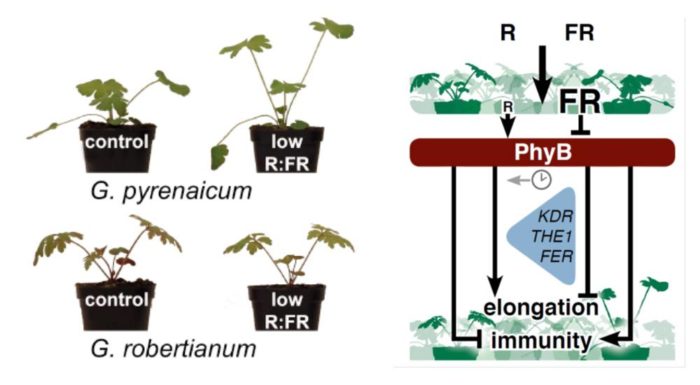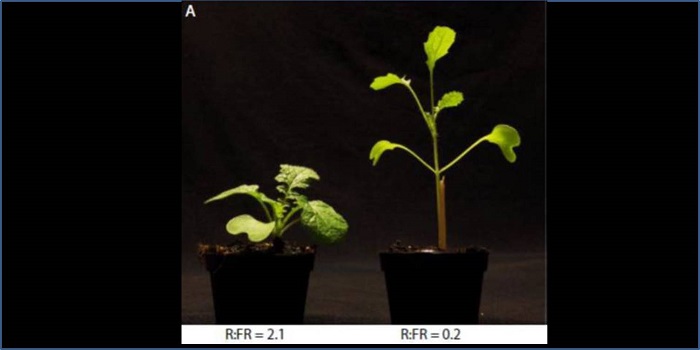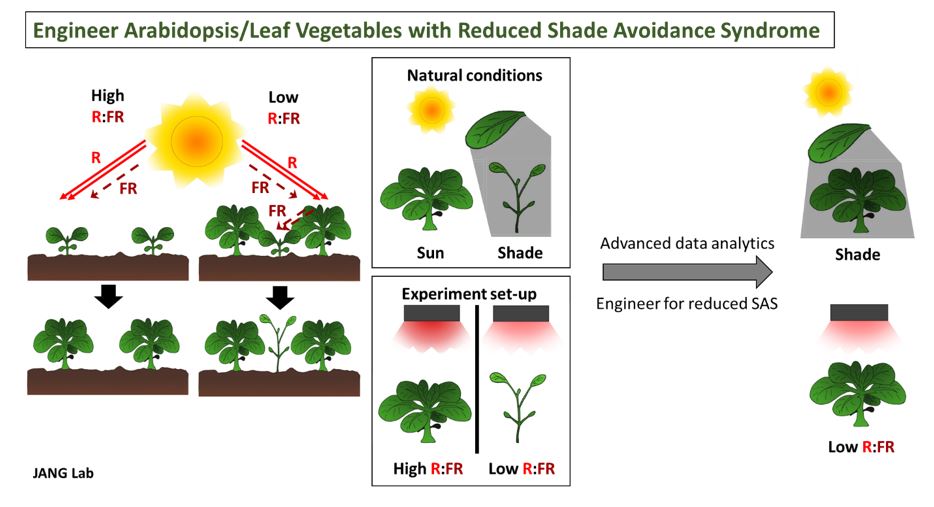Shade avoidance syndrome
Home » » Shade avoidance syndromeYour Shade avoidance syndrome images are ready. Shade avoidance syndrome are a topic that is being searched for and liked by netizens today. You can Find and Download the Shade avoidance syndrome files here. Find and Download all free vectors.
If you’re looking for shade avoidance syndrome images information connected with to the shade avoidance syndrome interest, you have pay a visit to the ideal site. Our site always gives you suggestions for seeing the highest quality video and picture content, please kindly surf and locate more enlightening video articles and images that match your interests.
Shade Avoidance Syndrome. Multiple signals and ecological consequences. The shade avoidance syndrome show how the misconcep-tion arose and emphasize the plurality of perception and response that is crucial to successful competition for light. Low RFR light is perceived by th. The shade avoidance syndrome.
 Plantae Contrasting Phytochrome Responses In Wild Plants Plantae From plantae.org
Plantae Contrasting Phytochrome Responses In Wild Plants Plantae From plantae.org
Responses is collectively known as the shade-avoidance syn-drome SAS Smith 1995. Several phytochrome genes mediate it. Common phenotypical changes related to SAS are changes in leaf hyponasty an increase in hypocotyl and internode elongation and extended petioles. THE SHADE AVOIDANCE SYNDROME Whenever plants grow in close proximity in forests in. The phenotypic similarities between physiological responses habitually referred to as the shade avoidance syndrome and other abiotic stress responses suggest plants may integrate common signalling mechanisms to respond to multiple perturbations in their natural environment. Cerdán PD Chory J 2003 Nature Lond 423881.
The shade avoidance syndrome show how the misconcep-tion arose and emphasize the plurality of perception and response that is crucial to successful competition for light.
Shadeavoidance research has mostly focused on cell expansion as the driving force of organ elongation. Multiple phytochromes sense changes in RFR ratio discussed in Smith Whitelam 1997 and although phyto-chrome B phyBisthepredominant phytochrome controlling SAS in response to low RFR ratio Franklin Quail 2010. Multiple signals and ecological consequences authorC. Multiple responses mediated by multiple phytochromes articleSmith1997TheSA titleThe shade avoidance syndrome. THE SHADE AVOIDANCE SYNDROME Whenever plants grow in close proximity in forests in. For plant cells to expand they need to loosen their cell walls so they can yield to the existing turgor pressure from the vacuoles.
 Source: researchgate.net
Source: researchgate.net
The SAS is initiated after perception of nearby vegetation as a reduction in the red to far-red ratio RFR of the incoming light. You can change your cookie settings at any time. The phenotypic similarities between physiological responses habitually referred to as the shade avoidance syndrome and other abiotic stress responses suggest plants may integrate common signalling mechanisms to respond to multiple perturbations in their natural environment. Multiple signals and ecological consequences. ArticleBallar2017TheSS titleThe shade-avoidance syndrome.
 Source: semanticscholar.org
Source: semanticscholar.org
Have you ever seen some shaded plants grow tall and spindly very fast while ones in sunlight are shorter and thicker. The phenotypic similarities between physiological responses habitually referred to as the shade avoidance syndrome and other abiotic stress responses suggest plants may integrate common signalling mechanisms to respond to multiple perturbations in their natural environment. Multiple responses mediated by multiple phytochromes authorH. The shade avoidance syndrome SAS refers to a set of plant responses aimed at anticipating eventual shading by potential competitors. The shade avoidance syndrome show how the misconcep-tion arose and emphasize the plurality of perception and response that is crucial to successful competition for light.

The shadeavoidance syndrome. The low RFR signal perceived by phytochromes initiates a set of responses collectively known as the shade avoidance syndrome intended to reduce the degree of. Low RFR light is perceived by th. Multiple responses mediated by multiple phytochromes authorH. Plants that grow tall and spindly trying to reach the sunlight are usually.
 Source: plantae.org
Source: plantae.org
Common phenotypical changes related to SAS are changes in leaf hyponasty an increase in hypocotyl and internode elongation and extended petioles. This adaptive response called the shade avoidance syndrome SAS allows the shaded plant to grow and compete effectively against its neighbors. Plants detect such neighboring vegetation as a reduction in the red to far-red ratio RFR of the incoming light. The shadeavoidance syndrome. The shade avoidance syndrome SAS refers to a set of plant responses aimed at anticipating eventual shading by potential competitors.
 Source: twitter.com
Source: twitter.com
The shade avoidance syndrome show how the misconcep-tion arose and emphasize the plurality of perception and response that is crucial to successful competition for light. This adaptive response called the shade avoidance syndrome SAS allows the shaded plant to grow and compete effectively against its neighbors. The shade avoidance syndrome SAS is a morphological and physiological response initiated by a decrease in light quantity and a change in light quali We use cookies to enhance your experience on our websiteBy continuing to use our website you are agreeing to our use of cookies. THE SHADE AVOIDANCE SYNDROME Whenever plants grow in close proximity in forests in. Multiple signals and ecological consequences.
 Source: plantae.org
Source: plantae.org
The low RFR signal perceived by phytochromes initiates a set of responses collectively known as the shade avoidance syndrome intended to reduce the degree of. Cerdán PD Chory J 2003 Nature Lond 423881. THE SHADE AVOIDANCE SYNDROME Whenever plants grow in close proximity in forests in. Multiple signals and ecological consequences authorC. Whitelam journalPlant Cell and Environment year1997 volume20 pages840-844 H.
Source:
The shade avoidance syndrome. Multiple phytochromes sense changes in RFR ratio discussed in Smith Whitelam 1997 and although phyto-chrome B phyBisthepredominant phytochrome controlling SAS in response to low RFR ratio Franklin Quail 2010. The shade-avoidance syndrome of plants results in elongated stem reduced leaf expansion and accelerated flowering under reduced light. The SAS is initiated after perception of nearby vegetation as a reduction in the red to far-red ratio RFR of the incoming light. The shadeavoidance syndrome.
 Source: distap.mit.edu
Source: distap.mit.edu
A series of experimental evidence showed that two photoreceptors phys and CRYs promote SAS. Have you ever seen some shaded plants grow tall and spindly very fast while ones in sunlight are shorter and thicker. This adaptive response called the shade avoidance syndrome SAS allows the shaded plant to grow and compete effectively against its neighbors. The responses to shade are generally referred to as the shade avoidance syndrome SAS and involve various developmental changes aimed to outgrow the neighbouring plants and are characterized by enhanced elongation reduced leaf expansion decreased branching and. The phenotypic similarities between physiological responses habitually referred to as the shade avoidance syndrome and other abiotic stress responses suggest plants may integrate common signalling mechanisms to respond to multiple perturbations in their natural environment.
 Source: researchgate.net
Source: researchgate.net
Multiple signals and ecological consequences. Common phenotypical changes related to SAS are changes in leaf hyponasty an increase in hypocotyl and internode elongation and extended petioles. The phenotypic similarities between physiological responses habitually referred to as the shade avoidance syndrome and other abiotic stress responses suggest plants may integrate common signalling mechanisms to respond to multiple perturbations in their natural environment. The phyB mutant seedlings display attenuated responses to a low RFR or to EOD far-red light leading to the proposal that phyB plays a key role in the shade-avoidance response Nagatani et al 1991. Multiple signals and ecological consequences.
 Source: researchgate.net
Source: researchgate.net
The responses to shade are generally referred to as the shade avoidance syndrome SAS and involve various developmental changes aimed to outgrow the neighbouring plants and are characterized by enhanced elongation reduced leaf expansion decreased branching and. The phyB mutant seedlings display attenuated responses to a low RFR or to EOD far-red light leading to the proposal that phyB plays a key role in the shade-avoidance response Nagatani et al 1991. Several phytochrome genes mediate it. Have you ever seen some shaded plants grow tall and spindly very fast while ones in sunlight are shorter and thicker. Responses is collectively known as the shade-avoidance syn-drome SAS Smith 1995.
 Source: researchgate.net
Source: researchgate.net
Plants that grow tall and spindly trying to reach the sunlight are usually. Shadeavoidance research has mostly focused on cell expansion as the driving force of organ elongation. The low RFR signal perceived by phytochromes initiates a set of responses collectively known as the shade avoidance syndrome intended to reduce the degree of current or future shade from neighbors by overtopping such competitors or inducing flowering to ensure seed production. The low RFR signal perceived by phytochromes initiates a set of responses collectively known as the shade avoidance syndrome intended to reduce the degree of. You can change your cookie settings at any time.
 Source: semanticscholar.org
Source: semanticscholar.org
Cerdán PD Chory J 2003 Nature Lond 423881. Light limitation caused by dense vegetation is one of the greatest threats to plant survival in natural environments. Have you ever seen some shaded plants grow tall and spindly very fast while ones in sunlight are shorter and thicker. Multiple signals and ecological consequences. Shade-avoidance syndrome of wild-type seedlings grown under a low RFR or in EOD far-red-light treatments.
 Source: researchgate.net
Source: researchgate.net
The phyB mutant seedlings display attenuated responses to a low RFR or to EOD far-red light leading to the proposal that phyB plays a key role in the shade-avoidance response Nagatani et al 1991. Multiple responses mediated by multiple phytochromes articleSmith1997TheSA titleThe shade avoidance syndrome. Multiple signals and ecological consequences. Have you ever seen some shaded plants grow tall and spindly very fast while ones in sunlight are shorter and thicker. Multiple signals and ecological consequences.
Source: researchgate.net
Shade-avoidance syndrome of wild-type seedlings grown under a low RFR or in EOD far-red-light treatments. The shade avoidance syndrome SAS is a morphological and physiological response initiated by a decrease in light quantity and a change in light quali We use cookies to enhance your experience on our websiteBy continuing to use our website you are agreeing to our use of cookies. The SAS is initiated after perception of nearby vegetation as a reduction in the red to far-red ratio RFR of the incoming light. Have you ever seen some shaded plants grow tall and spindly very fast while ones in sunlight are shorter and thicker. Multiple signals and ecological consequences authorC.
 Source: researchgate.net
Source: researchgate.net
The shade avoidance syndrome SAS refers to a set of plant responses aimed at anticipating eventual shading by potential competitors. The shade-avoidance syndrome of plants results in elongated stem reduced leaf expansion and accelerated flowering under reduced light. Shade-avoidance syndrome of wild-type seedlings grown under a low RFR or in EOD far-red-light treatments. The shade avoidance syndrome SAS refers to a set of plant responses aimed at anticipating eventual shading by potential competitors. Whitelam journalPlant Cell and Environment year1997 volume20 pages840-844 H.
 Source: slideserve.com
Source: slideserve.com
Multiple signals and ecological consequences authorC. Responses is collectively known as the shade-avoidance syn-drome SAS Smith 1995. Multiple signals and ecological consequences authorC. The low RFR signal perceived by phytochromes initiates a set of responses collectively known as the shade avoidance syndrome intended to reduce the degree of. Pierik journalPlant cell environment year2017 volume40 11 pages 2530-2543.
 Source: cell.com
Source: cell.com
Multiple responses mediated by multiple phytochromes articleSmith1997TheSA titleThe shade avoidance syndrome. Several phytochrome genes mediate it. Multiple responses mediated by multiple phytochromes authorH. Light limitation caused by dense vegetation is one of the greatest threats to plant survival in natural environments. ArticleBallar2017TheSS titleThe shade-avoidance syndrome.
 Source: researchgate.net
Source: researchgate.net
The SAS is initiated after perception of nearby vegetation as a reduction in the red to far-red ratio RFR of the incoming light. The shade avoidance syndrome SAS is a morphological and physiological response initiated by a decrease in light quantity and a change in light quali We use cookies to enhance your experience on our websiteBy continuing to use our website you are agreeing to our use of cookies. Shadeavoidance research has mostly focused on cell expansion as the driving force of organ elongation. For plant cells to expand they need to loosen their cell walls so they can yield to the existing turgor pressure from the vacuoles. The low RFR signal perceived by phytochromes initiates a set of responses collectively known as the shade avoidance syndrome intended to reduce the degree of.
This site is an open community for users to submit their favorite wallpapers on the internet, all images or pictures in this website are for personal wallpaper use only, it is stricly prohibited to use this wallpaper for commercial purposes, if you are the author and find this image is shared without your permission, please kindly raise a DMCA report to Us.
If you find this site adventageous, please support us by sharing this posts to your own social media accounts like Facebook, Instagram and so on or you can also bookmark this blog page with the title shade avoidance syndrome by using Ctrl + D for devices a laptop with a Windows operating system or Command + D for laptops with an Apple operating system. If you use a smartphone, you can also use the drawer menu of the browser you are using. Whether it’s a Windows, Mac, iOS or Android operating system, you will still be able to bookmark this website.